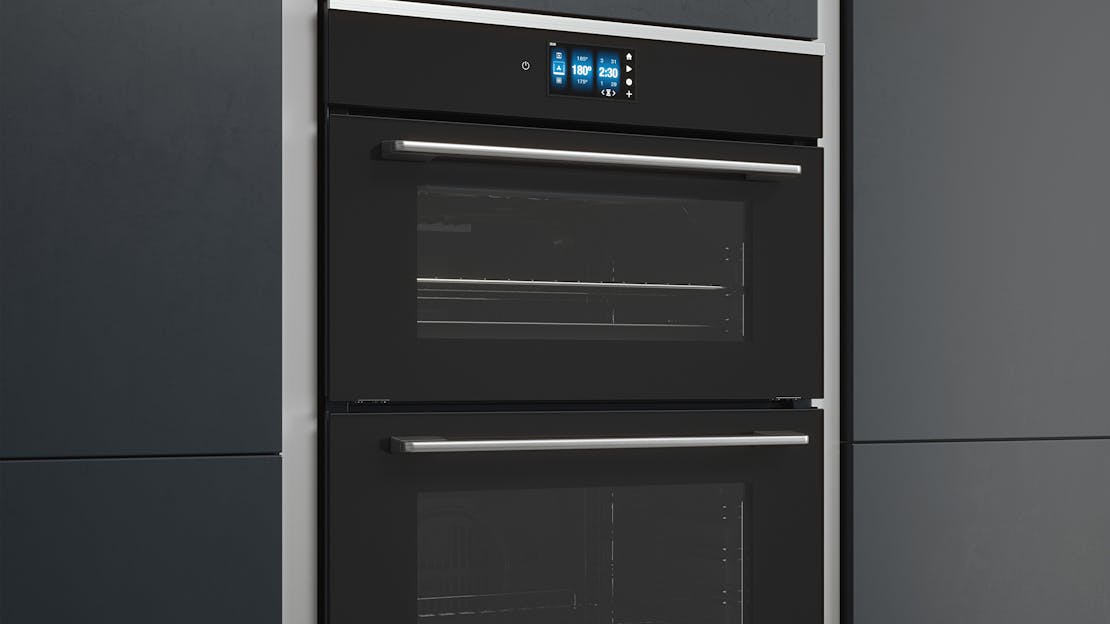
The Ultimate Guide to Double Ovens
Welcome to our comprehensive guide on double ovens, the ultimate kitchen companion for those who love to cook and bake with finesse. If you're in the market for a versatile cooking appliance that can revolutionise your culinary experience, you're in the right place. In this guide, we'll explore what double ovens are, how they differ from their single counterparts, and the numerous benefits they bring to your kitchen.
Most Viewed Sections
What is a double oven?
A double oven is a kitchen appliance designed for cooking or baking that comprises two separate oven compartments stacked on top of each other within a single unit. These ovens can be used simultaneously and offer various cooking options, making them a versatile addition to any kitchen. Here's how a double oven differs from a single oven and some of the benefits of having one in your kitchen:
1. Cooking Capacity:
- Double Oven: The primary advantage of a double oven is its increased cooking capacity. You have two separate cooking spaces, allowing you to prepare multiple dishes at different temperatures or cooking times simultaneously. This is especially useful when you're entertaining guests or cooking for a large family.
- Single Oven: A single oven has only one cooking compartment, limiting your cooking capacity. You may need to cook dishes sequentially, which can be time-consuming.
2. Cooking Flexibility:
- Double Oven: With a double oven, you can bake in one compartment and roast or grill in the other, or even use convection cooking in one while using conventional heating in the other. This flexibility enables you to cook a variety of dishes at once, which is perfect for holiday gatherings or elaborate meals.
- Single Oven: A single oven restricts your ability to cook multiple dishes with different cooking requirements simultaneously.
3. Energy Efficiency:
- Double Oven: While a double oven does use more energy when both compartments are in use, it can be more energy-efficient than using a single oven multiple times, especially when cooking large meals. You can also choose to use only one oven compartment for smaller meals, conserving energy.
- Single Oven: If you have a single oven and need to cook multiple dishes, you may end up running it multiple times, consuming more energy.
4. Time Savings:
- Double Oven: The time-saving aspect of a double oven is significant. You can significantly reduce the time spent on meal preparation by baking, roasting, or grilling multiple dishes simultaneously.
- Single Oven: With a single oven, you'll need to wait for one dish to finish cooking before starting another, which can extend meal preparation time.
5. Cooking Convenience:
- Double Oven: Double ovens often come with advanced features like convection cooking, precision temperature control, and digital timers, enhancing your cooking experience and helping you achieve better results.
- Single Oven: While single ovens also offer these features, the convenience of cooking multiple dishes at once is a significant advantage of a double oven.
In summary, a double oven provides increased cooking capacity, flexibility, and convenience compared to a single oven. It's an excellent choice for those who frequently prepare large meals or entertain guests. The ability to cook multiple dishes simultaneously, save time, and conserve energy make double ovens a valuable addition to any kitchen, particularly for those who enjoy cooking and baking. When writing your buying guide, be sure to highlight these benefits and discuss the different types of double ovens available to help your customers make an informed decision.
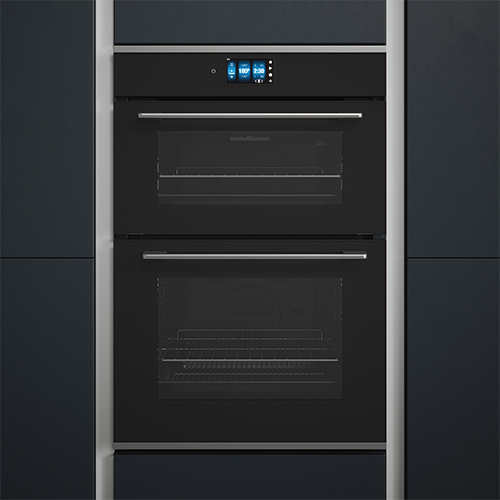
What types of double oven are available?
Let's cover the different types of double ovens, including convection vs. conventional double ovens and wall-mounted vs. range-style double ovens, along with their differences and advantages:
Convection vs. Conventional Double Ovens:
Convection Double Ovens:
- Difference: Convection double ovens are equipped with a fan and exhaust system that circulates hot air evenly around the food. This uniform heat distribution results in faster and more even cooking.
- Advantages:
- Faster Cooking: Convection ovens reduce cooking times, making them ideal for busy kitchens.
- Even Cooking: Food is cooked more uniformly, reducing the risk of unevenly cooked dishes.
- Versatility: Convection ovens are excellent for baking, roasting, and crisping.
Conventional Double Ovens:
- Difference: Conventional double ovens rely on radiant heating elements at the top and bottom of the oven for cooking. They do not have the fan-driven airflow of convection ovens.
- Advantages:
- Familiarity: Many home cooks prefer the familiarity of conventional ovens for traditional cooking methods.
- Simplicity: They are straightforward to use, making them great for those who prefer a no-frills approach to cooking.
Wall-mounted vs. Range-style Double Ovens:
Wall-mounted Double Ovens:
- Difference: Wall-mounted double ovens are separate units installed into your kitchen's cabinetry or wall. They offer flexibility in terms of placement and design.
- Advantages:
- Space Efficiency: Wall-mounted ovens save counter space and can be installed at an ergonomic height.
- Customization: You have the freedom to choose the oven's location based on your kitchen layout and design preferences.
- Separation of Cooking: You can use one oven for baking and the other for roasting simultaneously.
Range-style Double Ovens:
- Difference: Range-style double ovens are built into a freestanding or slide-in range, combining a cooktop and ovens in a single unit.
- Advantages:
- Compact Design: Ideal for kitchens with limited space, as they eliminate the need for a separate wall installation.
- Unified Look: They provide a cohesive appearance, as the oven and cooktop are integrated into one appliance.
- Convenience: Range-style double ovens offer a one-stop solution for cooking and baking.
When choosing between convection and conventional double ovens, consider your cooking style and preferences. Convection ovens excel in even and efficient cooking, while conventional ovens offer simplicity and familiarity.
For the installation of wall-mounted vs. range-style double ovens, assess your kitchen layout, available space, and design aesthetics. Wall-mounted ovens offer flexibility and customization, while range-style ovens are a space-saving, integrated solution. Ultimately, your choice will depend on your kitchen's layout, your cooking needs, and your personal preferences.
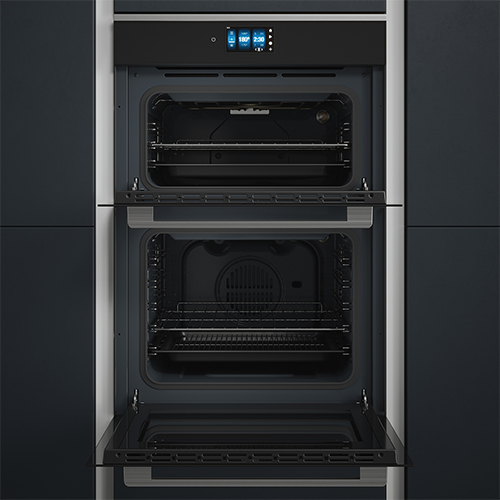
Double oven sizes and capacity
Double ovens come in a range of sizes and capacities to accommodate different cooking requirements. The two main factors to consider are the width and the internal capacity of each oven compartment.
Sizes and Capacities of Double Ovens:
Standard Width: Most double ovens have a standard width of 60 centimetres (cm). This size provides a good balance between cooking capacity and space efficiency in the kitchen.
Standard Height: Most double ovens have a height of approximately 90 centimetres (cm) or 72 centimetres (cm) if they are a built-under model which is designed to go under a worktop.
Internal Capacity: Apart from the width, the internal capacity of each oven compartment is a crucial consideration. The capacity is measured in litres or cubic feet and indicates how much food the oven can hold. It's essential to assess the capacity of both oven compartments, as they may differ.
How to Determine the Right Size:
Assess Your Cooking Needs: Consider how often you cook, the types of dishes you prepare, and the number of people you typically cook for. If you frequently entertain guests or have a large family, a larger double oven may be more suitable.
Kitchen Space: Measure the available space in your kitchen where you intend to install the double oven. Ensure that the width and height of the oven fit within the allocated space. Take into account any clearance requirements specified by the manufacturer for safe installation.
Cooking Style: Think about your cooking style. If you enjoy baking and roasting simultaneously, a standard-sized double oven with two spacious compartments may be ideal. Compact double ovens are suitable for smaller kitchens or when you need an extra oven for occasional use.
Consider Future Needs: Keep in mind any potential changes in your cooking habits or family size. Choosing a slightly larger oven than your current needs may be a wise investment for the future.
Energy Efficiency: Larger ovens may consume more energy, so consider the energy efficiency of the oven model you choose and how it aligns with your energy-saving goals.
Budget: Finally, factor in your budget. Larger and more feature-rich double ovens tend to be more expensive. Make sure your choice aligns with your budgetary constraints.
In conclusion, selecting the right size and capacity for your double oven involves assessing your cooking needs, available kitchen space, and future considerations. Take the time to measure your kitchen, evaluate your cooking habits, and consider your budget before making a decision. By doing so, you can ensure that your double oven is a perfect fit for your kitchen and culinary requirements.
Double oven fuel types Gas vs Electric
Here's a table summarising the pros and cons of gas vs electric double ovens:
| Aspect | Electric Double Ovens | Gas Double Ovens |
|---|---|---|
| Pros | Precise temperature control for even baking. | Quick heating and moist cooking environment. |
| Easy to clean smooth oven surfaces. | Lower operating costs. | |
| Suitable for a wide range of cooking methods. | Can work during power outages (ignition required). | |
| More commonly available and efficient. | ||
| Cons | Slower preheating times. | Less precise temperature control. |
| May dry out certain dishes. | Uneven heat distribution. | |
| Some models may require a dedicated circuit. | Limited baking capabilities. | |
| Limited grilling capabilities. | Higher initial installation cost for gas lines. |
Keep in mind that the pros and cons may vary depending on the specific brand and model of the double ovens, so it's important for consumers to consider their individual cooking needs and preferences when choosing between electric and gas double ovens.
Electric Double Ovens:
Electric double ovens offer precise temperature control, resulting in even and consistent baking results. They are easy to clean due to their smooth oven surfaces and are suitable for a wide range of cooking methods, including baking and roasting. Electric ovens are more commonly available and efficient.
Electric ovens may have slower preheating times and can sometimes dry out certain dishes. Some models may require a dedicated electrical circuit, potentially increasing electricity bills. They also have limited grilling capabilities.
Gas Double Ovens:
Gas double ovens heat up quickly and provide a moist cooking environment, ideal for roasting and grilling. They tend to have lower operating costs compared to electric ovens. Gas ovens can work during power outages (ignition required).
Gas ovens offer less precise temperature control and may have less even heat distribution. They are less common in some regions and have limited baking capabilities. The initial installation cost for gas lines may be higher.
Ultimately, the choice between electric and gas double ovens depends on your cooking preferences, available utilities, and budget. Electric ovens are known for precise baking, while gas ovens excel in quick heating and moist cooking. Consider these factors carefully when selecting the right type of double oven for your kitchen.
Features and technology available on double ovens
Incorporating these advanced features and technologies into your double oven can significantly enhance your cooking experience, making it more efficient, convenient, and enjoyable. When shopping for a double oven, consider which of these features align with your cooking style and preferences to choose the best appliance for your kitchen.
Touchscreen Controls:
Modern double ovens are often equipped with intuitive touchscreen controls that simplify the process of setting and adjusting cooking parameters. These digital interfaces provide a user-friendly experience, enabling users to select cooking modes, set timers, and adjust temperatures with a simple touch or swipe. The touchscreen displays typically offer clear and easy-to-read information, making it convenient to monitor the cooking progress. Some ovens also include interactive cooking guides and tutorials, assisting users in achieving perfect results for various dishes.
Wi-Fi Connectivity and Smart Features:
Wi-Fi connectivity has emerged as a significant advancement in oven technology. With Wi-Fi-enabled double ovens, users can remotely control and monitor their ovens using smartphone apps or voice assistants. This functionality allows for preheating the oven, adjusting cooking settings, or checking the cooking progress from anywhere within the home or even when away. Moreover, smart features may include recipe suggestions based on available ingredients, enabling users to discover new dishes and cooking techniques. Some ovens offer the convenience of voice commands, facilitating hands-free cooking.
Rapid Preheating:
Rapid preheating technology is designed to reduce the time required for the oven to reach the desired cooking temperature. This feature proves invaluable in saving time, particularly for busy cooks. Instead of waiting for the oven to preheat slowly, users can initiate cooking sooner, streamlining meal preparation. Rapid preheating typically employs advanced heating elements or techniques to achieve higher temperatures promptly, ensuring that the oven is ready for use when needed.
Temperature Probes:
Temperature probes are valuable tools for achieving precision in cooking. Integrated into the oven, these probes allow users to monitor the internal temperature of food accurately. This proves especially useful for meats, poultry, and other dishes where achieving the perfect level of doneness is critical. The temperature probe can be inserted into the food, and the oven will adjust its cooking process based on real-time temperature readings. This capability helps users avoid overcooking or undercooking their meals, resulting in consistently excellent results.
Self-Cleaning Options:
Self-cleaning options have transformed oven maintenance. These features employ high heat to incinerate food residues and spills, turning them into ash that can be easily wiped away once the cleaning cycle is complete. Some ovens offer various self-cleaning modes, including shorter steam cleaning cycles that use steam to loosen and soften dirt, making it easier to clean without the need for harsh chemicals. Self-cleaning options save users time and effort, ensuring that the oven remains in top condition with minimal manual cleaning required.
What functions are available on a double oven
These common functions cater to a wide range of cooking needs, making double ovens versatile and suitable for various culinary tasks. The specific functions may vary depending on the brand and model of the double oven, but these are the functions you're likely to find on most ovens.
Conventional Baking: The conventional baking function is the standard mode for baking in both the top and bottom ovens. It uses heating elements at the top and bottom to provide even heat distribution, making it suitable for a wide range of baking recipes.
Convection Baking: In convection baking, the lower oven typically incorporates a fan that circulates hot air evenly. This function is excellent for achieving even cooking and browning, making it ideal for roasting meats and vegetables, as well as baking multiple trays of cookies or pastries simultaneously.
Grilling: Both ovens usually feature a grilling function, allowing you to cook food quickly by applying direct heat from the top heating element. This function is perfect for browning and crisping the tops of dishes like casseroles or melting cheese on dishes.
Dual Cooking: Some double ovens offer a dual cooking function, allowing you to use different cooking modes in each oven compartment simultaneously. This is handy when you want to bake a dessert and roast a main course at the same time.
Defrosting: Many double ovens have a defrosting function, which uses low-temperature settings and a fan to thaw frozen food quickly and safely.
Keep Warm: A keep warm function helps maintain a low, consistent temperature to keep cooked dishes warm without overcooking them. This is useful when you're waiting for all components of a meal to be ready.
Convection Roasting: In the lower convection oven, the convection roasting function uses a fan to evenly distribute heat while roasting meats or poultry. It's excellent for achieving crisp, golden skin and juicy interiors.
Delayed Start and Timed Cooking: Many double ovens come equipped with delayed start and timed cooking features, allowing you to set when the oven turns on and off, making meal planning and preparation more flexible.
Typical Configuration: Conventional Top, Convection Bottom:
In the typical configuration of a double oven, the top compartment is conventionally heated, while the bottom one is equipped with a convection fan. This setup offers a versatile cooking experience, as you can use the top oven for traditional baking and the lower convection oven for roasting, baking multiple trays of cookies, or cooking dishes that benefit from even heat circulation.
The conventionally heated top oven is great for everyday baking needs, such as cakes, muffins, and casseroles, while the convection lower oven is perfect for more complex cooking tasks like roasting a turkey, achieving even browning on casseroles, or preparing large quantities of baked goods.
This combination of conventional and convection ovens in a double oven allows you to make the most of different cooking techniques and ensures you have the versatility needed for various culinary adventures in your kitchen.
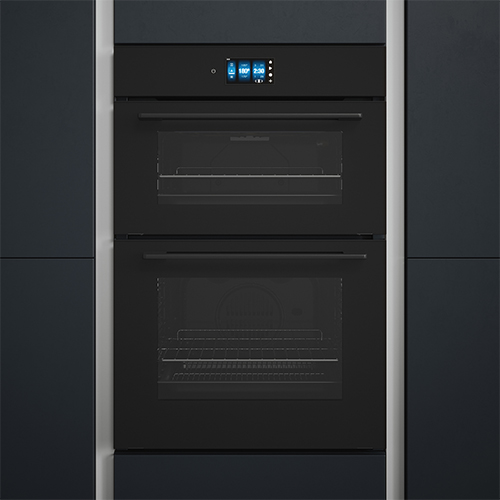
Oven racks and shelving in double ovens
Adjustable racks and shelving options in an oven are essential for flexible cooking, optimised results, and efficient use of space. These features enable you to tailor the oven's interior, ensuring even cooking, accommodating various sizes and shapes of cookware, and facilitating multi-level cooking. They also enhance access to food and adapt to different cooking techniques, such as grilling or roasting, enhancing the overall versatility of the oven and making meal preparation more convenient and efficient.
Rack placement for different cooking tasks
Proper rack placement in your oven is crucial for achieving the best cooking results for different dishes. Here's a general guideline for rack placement based on common cooking tasks:
| Cooking Task | Rack Placement |
|---|---|
| Baking (Cookies, Cakes, Bread) | For even browning and rising, place racks in the centre or slightly higher position. |
| Use the middle rack for most baked goods. | |
| For large loaves of bread or deep cakes, use a lower rack. | |
| Roasting (Meats and Poultry) | Place the rack in the lowest position to allow enough space for a roasting pan. |
| Ensure the meat or poultry is centred on the rack. | |
| Grilling (Steaks, Fish, etc.) | Use the topmost rack position for grilling. |
| Adjust the rack height to achieve desired doneness (closer for searing, higher for less direct heat). | |
| Casseroles and Au Gratin Dishes | Place the rack in the middle position for even cooking. |
| Pizza (Homemade or Frozen) | For homemade pizza, use the lower rack for a crispy crust. |
| For frozen pizza, follow the manufacturer's instructions, typically placing it on a middle rack. | |
| Convection Cooking (General) | Use the middle rack for even air circulation. |
| Multiple Dishes at Once (Multi-level Cooking) | Space racks evenly to avoid obstructing airflow. |
| Rotate dishes or pans halfway through cooking for even results. | |
| Keep Warm or Slow Cooking | Use the lowest rack position to prevent overcooking. |
| Browning or Finishing | Use the uppermost rack to quickly brown or finish dishes. |
Remember that the specific rack placement may vary depending on the oven model and the size of your dishes or pans. Always refer to the manufacturer's recommendations in your oven's user manual for optimal results.
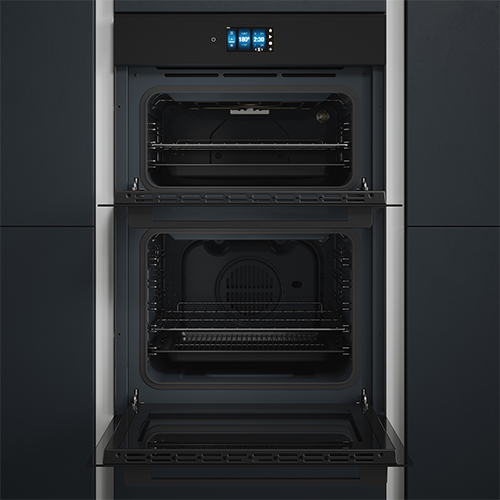
Choosing an energy-efficient double oven
Opt for an oven size that aligns with your cooking needs to avoid excessive energy consumption when heating a larger oven. Additionally, consider the insulation and sealing of the oven; well-insulated ovens with proper sealing retain heat effectively, diminishing the requirement for additional energy. Look for double ovens equipped with a convection feature in the lower oven, as convection ovens employ fans to circulate hot air, leading to reduced cooking time and energy usage. Furthermore, explore ovens offering alternative cleaning methods, such as steam cleaning, which can prove to be more energy-efficient than high-heat self-cleaning cycles.
Reducing Energy Consumption While Cooking:
To diminish energy consumption during cooking, adopt efficient preheating practices, preheating only when necessary. Employ suitably sized cookware to match the dish's size, ensuring efficient heat distribution and reduced cooking times. Keep the oven door closed as much as possible during cooking to retain heat and minimise energy loss. Use the oven light and window to monitor the cooking progress instead of frequently opening the door. Batch cooking is another energy-saving strategy, as it enables you to prepare multiple dishes in a single oven session, reducing overall cooking time and energy usage. Properly thaw frozen food in the refrigerator before cooking to minimise the time and energy required to reach the desired cooking temperature. Finally, select the appropriate oven for the task at hand; if you're cooking a small dish, opt for the smaller oven in your double oven unit rather than heating the larger one, as this can result in energy savings.
Maintenance and cleaning a double oven
Properly cleaning and maintaining your double oven is essential to ensure its longevity and optimal performance. Here's a guide on how to clean and maintain both the interior and exterior of your oven:
Interior Cleaning:
- Regular Wipe Down: After each use, allow the oven to cool down, then wipe the interior with a damp cloth or sponge to remove any food residue or spills.
- Remove Oven Racks: Take out the oven racks and clean them separately. Soak them in warm, soapy water and scrub away any baked-on grime using a non-abrasive scrubbing pad.
- Self-Cleaning Option: If your oven features a self-cleaning function, use it periodically to incinerate food residues. Follow the manufacturer's instructions for the self-cleaning cycle.
- Steam Cleaning: Some ovens offer a steam cleaning option, which employs steam to loosen dirt, making it easier to wipe away. This is a more eco-friendly and energy-efficient cleaning method compared to self-cleaning.
- Oven Liners: Consider using oven liners or mats to catch spills and prevent them from adhering to the oven floor. These liners are easier to clean or replace than the oven interior.
- Stainless Steel Interiors: If your oven has a stainless steel interior, use a stainless steel cleaner to preserve its shine and appearance.
Exterior Cleaning:
- Exterior Wipe Down: Wipe the exterior of the oven, including the control panel and door, with a damp cloth and a mild detergent. Avoid abrasive cleaners that could scratch the finish.
- Stainless Steel Exterior: If your oven features a stainless steel exterior, use a stainless steel cleaner and a soft cloth to maintain its appearance and prevent smudges.
- Control Panel: Exercise caution when cleaning the control panel. Avoid excessive moisture, as it could harm the electronics. Use a damp cloth and, if necessary, consult your manual for specific cleaning recommendations.
Handling Spills and Stains:
- Immediate Action: Address spills and stains promptly to prevent them from baking onto the oven surfaces. Allow the oven to cool before attempting to clean.
- Spill Containment: If a spill occurs while cooking, use a spatula or spoon to carefully remove any excess food or liquids without spreading the spill further.
- Baking Soda Paste: For stubborn stains, create a paste with baking soda and water. Apply it to the stain and leave it for some time. Then, scrub gently with a soft cloth or sponge.
- Commercial Oven Cleaners: If necessary, you can use a commercial oven cleaner following the manufacturer's instructions. Ensure good ventilation when using these products and wear gloves.
- Avoid Harsh Abrasives: Refrain from using abrasive scrubbing pads, steel wool, or harsh chemicals, as they could damage the oven's surfaces.
- Spill Prevention: To prevent spills and drips, use baking sheets, oven-safe containers, and oven liners when cooking dishes that may bubble over.
Regular cleaning and stain management not only keep your double oven looking and smelling fresh but also contribute to its efficient operation and longevity. Follow the manufacturer's guidelines for cleaning and maintenance specific to your oven model.
Double oven installation and ventilation
Proper installation of a double oven is essential for safety and efficient operation. It is strongly recommended to engage a qualified engineer or technician for this task. Here are the steps for correctly installing a double oven, along with the significance of ventilation and exhaust systems:
Installation Steps for a Double Oven with a Qualified Engineer:
Select the Location: Collaborate with a qualified engineer to choose a suitable location for your double oven. Ensure it complies with the manufacturer's recommendations regarding clearances from walls, cabinets, and adjacent appliances. Sufficient space is necessary to accommodate the oven comfortably.
Check Electrical and Gas Connections: The qualified engineer will verify that your kitchen has the necessary electrical or gas connections in the chosen location. If not, they will take the necessary steps to install the required connections in accordance with local building codes and safety regulations.
Measure and Prepare: With the guidance of the engineer, measure the dimensions of the oven to confirm it will fit correctly in the designated space. If needed, the engineer will coordinate the removal of any existing appliances or cabinets to create ample room. They will also ensure that the floor is level and capable of supporting the oven's weight.
Secure the Oven: The qualified engineer will carefully position the double oven in the designated space, aligning it with the mounting brackets or cabinet openings. They will ensure it is level both vertically and horizontally and securely attach the oven according to the manufacturer's instructions.
Connect Utilities: If your double oven is electric or gas-powered, the engineer will handle the connection to the electrical or gas supply following all safety guidelines, local regulations, and manufacturer specifications.
Test the Oven: Before handing it over for use, the qualified engineer will perform a thorough test run to ensure that the oven operates correctly, heats up to the desired temperature, and all functions are working as intended.
Importance of Ventilation and Exhaust Systems:
Proper ventilation and exhaust systems are crucial when installing a double oven for several reasons:
Heat Dissipation: Ovens generate a significant amount of heat during operation. Adequate ventilation helps dissipate this heat, preventing the kitchen from overheating and maintaining a comfortable cooking environment.
Odour and Smoke Removal: Cooking produces various odours and sometimes smoke. An exhaust system efficiently removes cooking odours and smoke, improving indoor air quality and preventing lingering smells in your home.
Moisture Control: Ventilation systems help control moisture levels in the kitchen, essential for preventing mould and mildew growth. Proper moisture control also protects kitchen cabinets and countertops from damage.
Safety: Adequate ventilation is essential, particularly when using gas ovens, to remove combustion by-products like carbon monoxide from the kitchen, reducing health risks.
Efficiency: A well-ventilated kitchen promotes more efficient cooking, as it helps maintain a stable and comfortable cooking environment. It can also contribute to energy savings by reducing the need for excessive cooling during hot weather.
When installing a double oven, always enlist the services of a qualified engineer or technician to ensure the safety and reliability of the installation. Proper installation and ventilation are critical for efficient and safe operation.
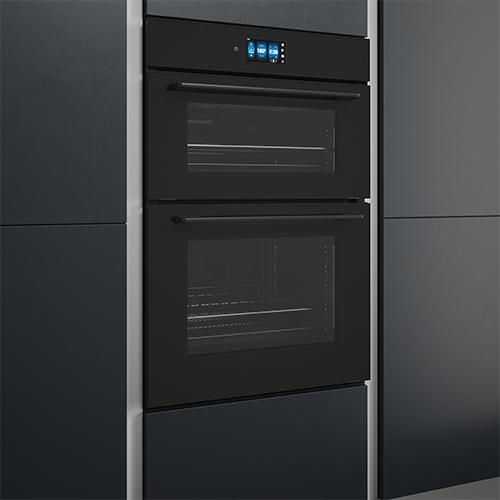
Safety considerations of a double oven
Safety is paramount when using double ovens. Here are some key safety considerations and tips:
Manual Review: Start by thoroughly reading and understanding the manufacturer's manual for your double oven. It provides essential safety instructions and guidelines specific to your appliance.
Professional Installation: Ensure that your double oven is professionally installed by a qualified engineer or technician to guarantee safe electrical and gas connections and secure installation.
Childproofing: If you have young children, consider installing childproof locks on the oven doors to prevent accidental access and burns.
Proper Ventilation: Ensure your kitchen has adequate ventilation and exhaust systems to dissipate heat and remove cooking odours, enhancing safety and comfort.
Avoid Overcrowding: Don't overcrowd the oven with too many dishes, as it can hinder proper air circulation and pose a fire hazard.
Use Oven Mitts: Always use oven mitts or heat-resistant gloves when handling hot cookware, and keep a designated area for hot items.
Cautious Door Handling: Open the oven door slowly while cooking, standing to the side to allow hot air and steam to escape safely.
Monitor Cooking: Stay in or near the kitchen while using the oven, regularly checking your dishes and setting timers to prevent overcooking or burning.
Avoid Self-Cleaning During Cooking: Don't initiate the self-cleaning cycle while cooking due to extremely high temperatures; schedule it for when the oven is not in use.
Clean Regularly: Keep the oven clean by promptly cleaning spills and residues to reduce the risk of smoke or fire.
Use Cookware Safely: Choose oven-safe cookware, avoiding items with non-oven-safe materials or plastic handles.
Gas Oven Safety: If you have a gas oven, be vigilant for gas odours, and if detected, turn off the oven, ventilate the area, and contact an engineer or your gas supplier immediately.
Emergency Procedures: Familiarise yourself with emergency procedures for your oven, such as turning off gas or electricity during malfunctions.
Regular Maintenance: Schedule periodic maintenance and safety checks by a qualified technician to ensure all components are in good working order.
By adhering to these safety considerations and tips, you can confidently use your double oven, prioritising safety in the kitchen to ensure enjoyable and secure cooking experiences.
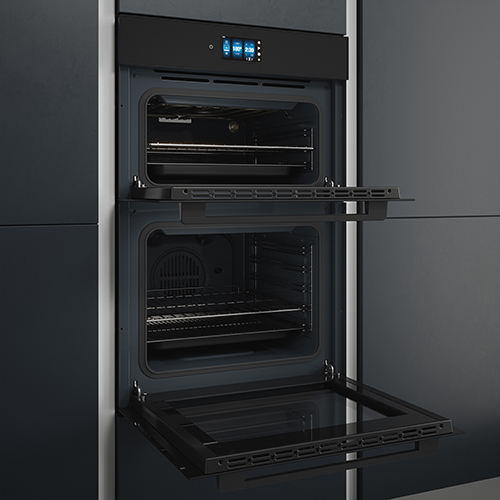
Budget and pricing of double ovens
The price of double ovens can vary widely depending on several factors, including brand, size, type, features, and design. Here's a general price range to give you an idea:
Entry-Level: Basic double ovens without many advanced features can start at around £300 to £600.
Mid-Range: Mid-tier double ovens with additional features, better build quality, and more cooking options typically range from £600 to £1,000.
High-End: Premium double ovens with top-of-the-line features, advanced technology, and sleek designs can cost £1,000 or more, with some high-end models reaching several thousand pounds.
Factors Affecting Cost:
Several factors can affect the cost of a double oven:
Type: Wall-mounted double ovens are often more expensive than range-style double ovens due to their built-in design.
Size: Larger ovens with greater cooking capacity tend to be pricier.
Fuel Type: Electric double ovens are generally more affordable than their gas counterparts.
Features: Additional features such as convection cooking, smart technology, self-cleaning options, and touchscreen controls can increase the price.
Brand: Established brands with a reputation for quality often command higher prices.
Design: Aesthetic elements like stainless steel finishes and custom handles can also add to the cost.
Tips for Finding the Best Deals and Discounts:
To find the best deals and discounts on double ovens, consider these tips:
Compare Prices: Visit multiple retailers and online stores to compare prices. Look for sales and promotions.
Shop Seasonally: Appliance sales tend to coincide with holidays like Black Friday, Christmas, and Boxing Day. Shopping during these periods can yield significant discounts.
Consider Open-Box or Clearance Models: Retailers may offer open-box or clearance models at reduced prices. These items are typically new or unused but may have minor cosmetic imperfections.
Refurbished Models: Consider refurbished double ovens from reputable sellers, which are typically tested and restored to like-new condition.
Read Reviews: Before making a decision solely based on price, read reviews to ensure the oven meets your needs and expectations.
Remember that the best deal is not always the cheapest option. Consider the long-term value, reliability, and features of the double oven to ensure it meets your cooking needs and expectations while staying within your budget.
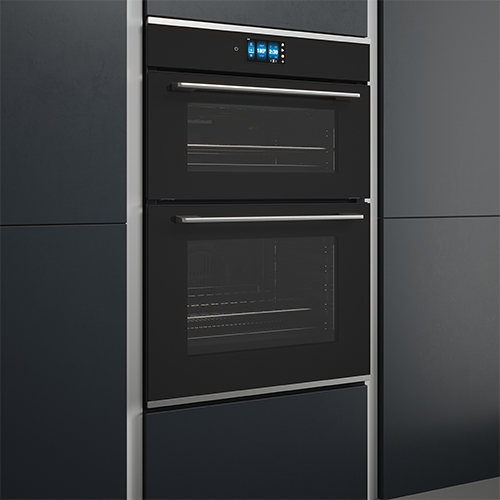
Why warranty and support is important on double ovens
Protection Against Malfunctions
Warranties provide coverage for repairs or replacements in case of malfunctions or defects in your double oven during the warranty period. This protection can save you from significant repair expenses.
Peace of Mind
A warranty offers peace of mind, allowing you to use your oven confidently without worrying about unexpected breakdowns or repair costs.
Longevity Assurance
A manufacturer's warranty often reflects their confidence in the appliance's quality and durability. Longer warranty periods can indicate a higher level of trust in the oven's longevity.
Quality Assurance
Appliances with comprehensive warranties may be of higher quality, as manufacturers are more likely to back their products with extended coverage when they are built to last.
Prompt Repairs
In case of a covered issue, warranties typically ensure prompt repairs or replacements, minimizing downtime and inconvenience in your kitchen.
Cost Savings
Repairing modern appliances, including double ovens, can be expensive. A warranty can save you from bearing the full cost of repairs, as parts and labour expenses are often covered.
The Importance of After-Sales Support:
Technical Assistance
After-sales support teams can provide technical assistance, helping you troubleshoot minor issues over the phone or through online resources.
Maintenance Tips
They offer advice on proper maintenance practices, ensuring your double oven operates efficiently and remains in good condition.
Spare Parts
If your oven requires replacement parts, after-sales support can help you source genuine components, ensuring optimal performance.
Product Knowledge
Manufacturers' support teams have in-depth knowledge of their products, allowing them to provide valuable insights and solutions to common problems.
User Manuals
They assist you in accessing and understanding user manuals and guides, helping you get the most out of your oven's features.
Recall Notifications
In the rare event of a product recall, after-sales support can inform you and guide you through the necessary steps to address safety concerns.
Overall, warranties and after-sales support contribute to a positive ownership experience. When purchasing a double oven, it's wise to consider the length and coverage of the warranty and the reputation of the manufacturer or retailer for their after-sales service. This ensures that you not only have a reliable appliance but also access to assistance and protection should any issues arise during its use.
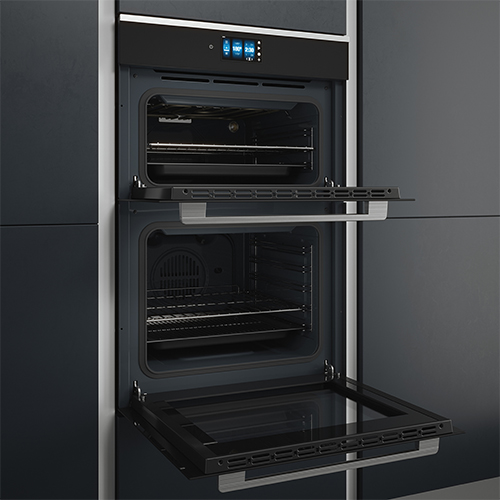
In conclusion
In this comprehensive guide to double ovens, we've explored every aspect of these versatile kitchen appliances, aiding you in making well-informed decisions. We've covered types, sizes, features, benefits, and installation considerations, ensuring you're equipped to select the perfect double oven for your kitchen. Whether you're a passionate home cook or a busy family chef, our guide has provided insights into choosing the right oven for your needs, optimizing cooking techniques, and enhancing energy efficiency. Additionally, we've emphasised the importance of warranties and after-sales support in safeguarding your investment. With this knowledge, you're ready to elevate your culinary experiences and make every meal a masterpiece with your double oven.
